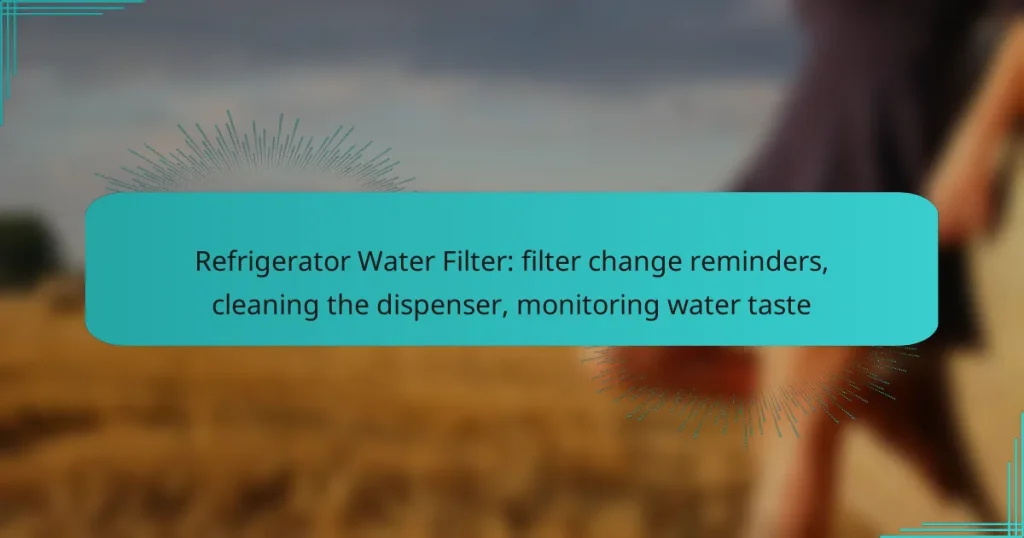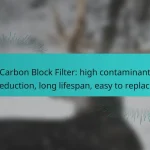Maintaining your refrigerator’s water filter is crucial for ensuring clean and great-tasting drinking water. Regularly changing the filter every six months, along with cleaning the water dispenser, helps prevent contaminants and bacteria buildup. By monitoring the taste of your water, you can ensure that it remains fresh and safe for consumption.
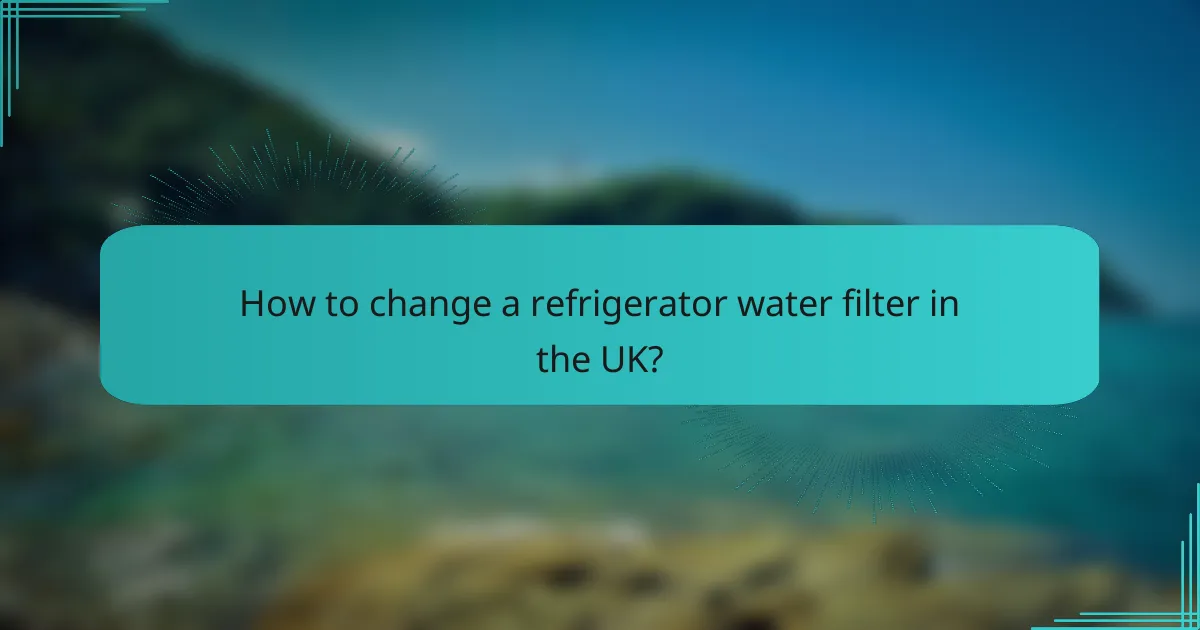
How to change a refrigerator water filter in the UK?
Changing a refrigerator water filter in the UK is a straightforward process that ensures clean drinking water. Most filters need replacement every six months, but this can vary based on usage and water quality.
Step-by-step guide for popular models
To change the water filter, first, locate the filter compartment, which is usually found inside the refrigerator or at the back. Turn off the water supply to prevent leaks, then remove the old filter by twisting or pulling it out, depending on the model.
Next, take the new filter and insert it into the compartment, ensuring it is securely in place. Finally, turn the water supply back on and run the water for a few minutes to flush out any air and impurities.
Recommended filter brands for UK refrigerators
Some of the top brands for refrigerator water filters in the UK include Brita, AquaCrest, and Waterdrop. These brands are known for their reliability and compatibility with various refrigerator models.
When selecting a filter, ensure it meets UK standards for water quality and is compatible with your specific refrigerator model. Reading customer reviews can also help in making an informed choice.

When should you change your refrigerator water filter?
You should change your refrigerator water filter approximately every six months to ensure optimal water quality and taste. Regular replacement prevents contaminants from building up and affecting the performance of your water dispenser.
Common indicators for filter replacement
Several signs indicate that it’s time to replace your refrigerator water filter. A noticeable change in water taste or odor is a primary indicator that the filter may be clogged or ineffective. Additionally, if the water flow from the dispenser slows significantly, it could signal that the filter is nearing the end of its lifespan.
Another common indicator is the filter change light on your refrigerator, if equipped. This light typically illuminates based on usage, reminding you when to replace the filter.
Manufacturer recommendations for filter lifespan
Most manufacturers recommend changing the water filter every six months, but this can vary based on usage and water quality. For households with heavy water usage or those using well water, more frequent changes may be necessary, possibly every three to four months.
Always refer to your refrigerator’s user manual for specific guidelines, as some models may have different requirements. Following these recommendations helps maintain water quality and ensures your refrigerator operates efficiently.

How to clean the water dispenser in a refrigerator?
Cleaning the water dispenser in a refrigerator is essential for maintaining water quality and hygiene. Regular cleaning prevents mold and bacteria buildup, ensuring that the water tastes fresh and remains safe to drink.
Cleaning methods for different dispenser types
Water dispensers vary in design, and cleaning methods should be tailored accordingly. For a push-button dispenser, use a soft cloth or sponge to wipe down the exterior and nozzle, ensuring to remove any residue. For a pull-down spout, detach any removable parts and wash them separately in warm, soapy water.
For integrated dispensers, a mixture of vinegar and water can effectively clean the internal components. Run the solution through the dispenser, then flush with clean water to eliminate any lingering vinegar taste.
Recommended cleaning products for safe use
When cleaning your refrigerator’s water dispenser, choose non-toxic and food-safe cleaning products. A simple solution of warm water and mild dish soap is often sufficient for regular maintenance.
For deeper cleaning, consider using white vinegar or a diluted bleach solution (one tablespoon of bleach per gallon of water). Always rinse thoroughly after using bleach to ensure no residue remains. Avoid abrasive cleaners that can scratch surfaces or leave harmful residues.
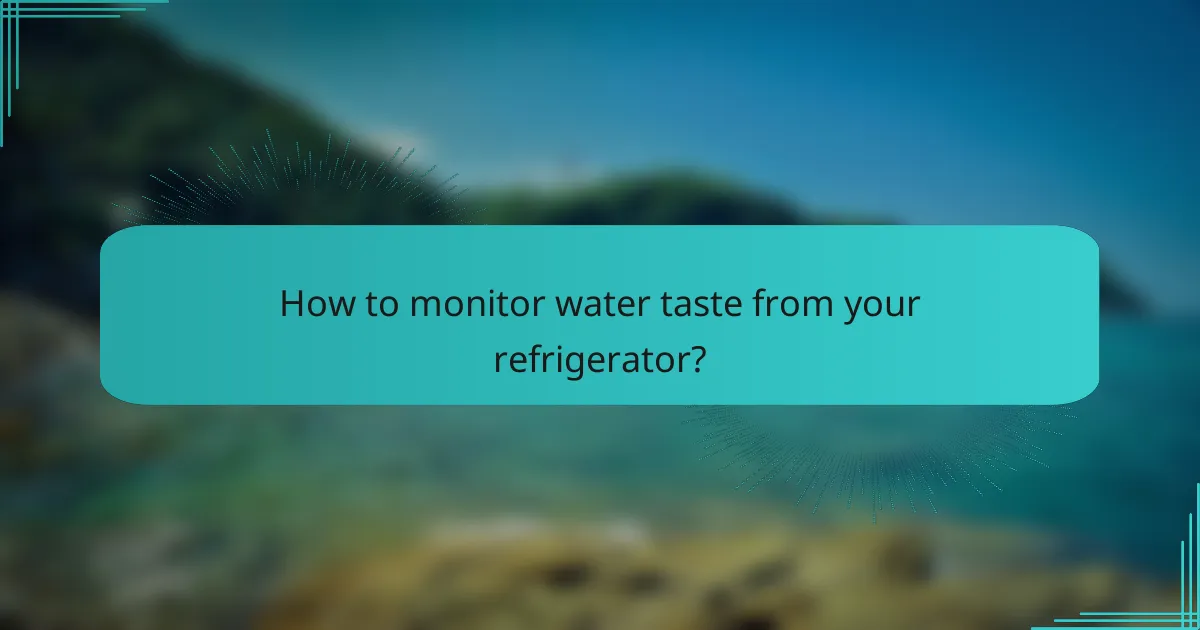
How to monitor water taste from your refrigerator?
Monitoring the taste of water from your refrigerator is essential for ensuring its quality and safety. Regularly checking for any changes in flavor can help you identify potential issues with your water filter or the water supply itself.
Signs of water quality issues
Common signs of water quality issues include unusual tastes, odors, or cloudiness. If your water has a metallic or chemical flavor, it may indicate contamination or a failing filter. Additionally, if you notice a change in the clarity or color of the water, it is crucial to investigate further.
Other indicators can be the presence of sediment or particles in the water. If you experience any of these signs, consider checking your refrigerator’s water filter and replacing it if necessary.
Testing kits for refrigerator water quality
Testing kits for refrigerator water quality are available and can help you assess the safety of your drinking water. These kits typically test for common contaminants such as chlorine, lead, and bacteria. They are user-friendly and can provide results within minutes.
When selecting a testing kit, look for those that meet EPA standards for water testing. Regular testing can help you maintain water quality and ensure that any issues are addressed promptly, keeping your drinking water safe and pleasant to consume.
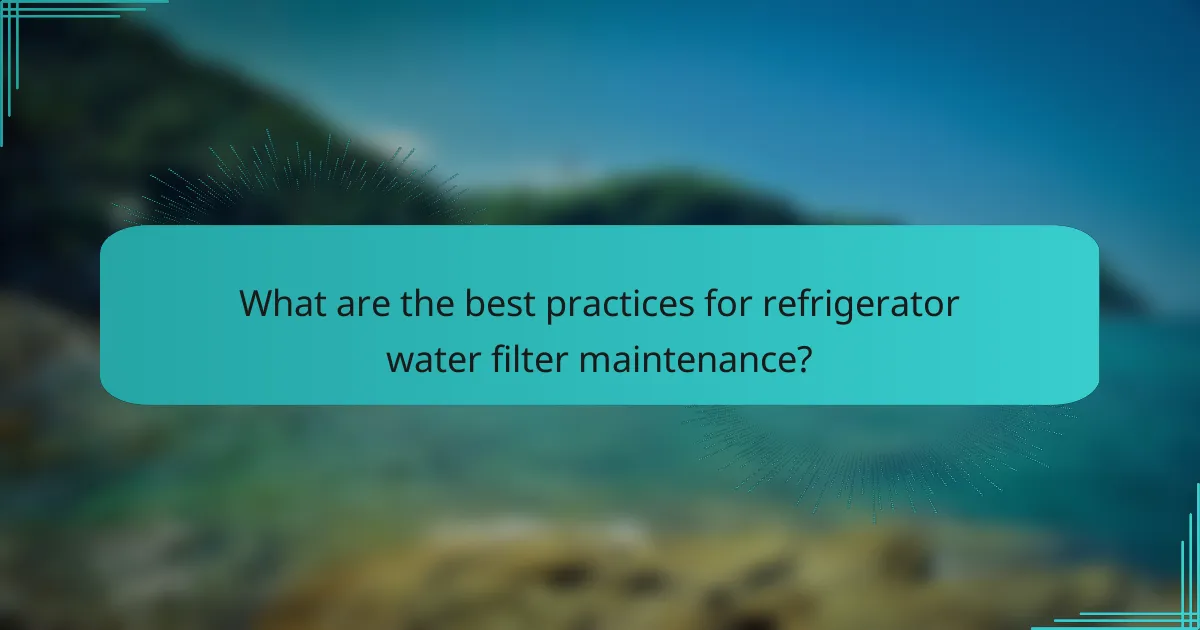
What are the best practices for refrigerator water filter maintenance?
To ensure optimal performance and water quality, regularly maintaining your refrigerator water filter is essential. This includes timely filter changes, cleaning the dispenser, and monitoring the taste of the water.
Regular maintenance tips for longevity
Changing the water filter every six months is a common guideline, but some filters may require replacement sooner, especially in areas with hard water. Regularly check for any signs of reduced water flow or off-tastes, which can indicate a clogged filter.
Cleaning the water dispenser and surrounding areas every few months can prevent buildup of bacteria and mold. Use a mixture of vinegar and water for cleaning, ensuring all surfaces are wiped down thoroughly.
Importance of proper installation
Correct installation of the water filter is crucial for its effectiveness and longevity. Ensure that the filter is securely fitted according to the manufacturer’s instructions to prevent leaks and ensure proper water flow.
Improper installation can lead to water contamination or filter failure. Always double-check that the filter is aligned correctly and that any locking mechanisms are engaged. If you encounter resistance during installation, do not force it; instead, recheck the alignment.

What are the benefits of using a refrigerator water filter?
Using a refrigerator water filter provides cleaner, better-tasting water by removing impurities and contaminants. This not only enhances the flavor of drinking water but also contributes to overall health and environmental sustainability.
Health benefits of filtered water
Filtered water can significantly reduce harmful substances such as chlorine, lead, and bacteria, which may be present in tap water. By consuming cleaner water, you lower the risk of gastrointestinal diseases and other health issues associated with contaminants.
Additionally, many water filters retain essential minerals while removing harmful elements, ensuring that you still receive beneficial nutrients. This balance is crucial for maintaining hydration and overall well-being.
Environmental impact of using filters
Using refrigerator water filters can help reduce plastic waste associated with bottled water consumption. By filtering tap water, you decrease the demand for single-use plastic bottles, which contributes to environmental pollution.
Moreover, many filters are designed to be recyclable, further minimizing their ecological footprint. Choosing a filter system over bottled water can lead to a significant reduction in plastic waste and a more sustainable lifestyle.
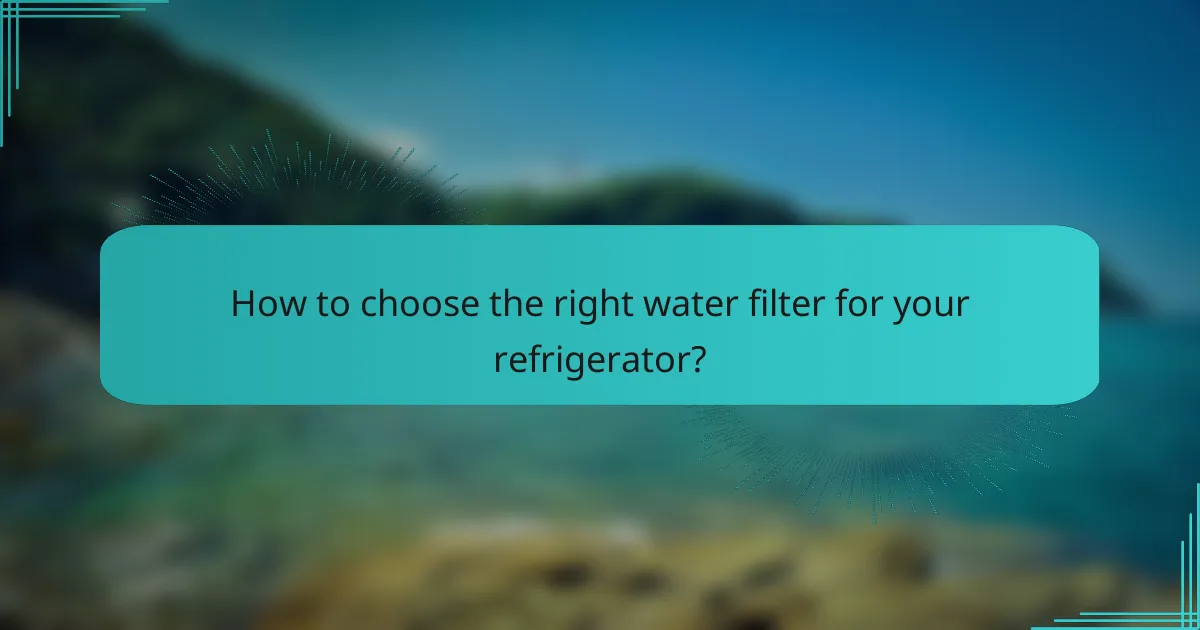
How to choose the right water filter for your refrigerator?
Choosing the right water filter for your refrigerator involves considering compatibility, filtration capabilities, and maintenance requirements. Look for filters that meet your specific needs, such as reducing contaminants and improving taste, while ensuring they fit your refrigerator model.
Key features to consider
When selecting a refrigerator water filter, focus on the filter’s certification, such as NSF/ANSI standards, which indicate its effectiveness in removing specific contaminants. Additionally, consider the filter’s lifespan, typically ranging from six months to a year, and the ease of installation and replacement.
Another important feature is the flow rate, which affects how quickly you can access filtered water. Filters with higher flow rates may be more convenient, especially for households with higher water consumption.
Comparison of top-rated filters in the UK
In the UK, several top-rated refrigerator water filters include brands like Brita, AquaCrest, and Waterdrop. These filters are known for their ability to reduce chlorine, lead, and other impurities, significantly enhancing water taste and safety.
For example, the Brita Maxtra+ filter is popular for its affordability and effectiveness, while the AquaCrest AQF-FF-1000 offers a longer lifespan and high filtration capacity. When comparing these options, consider factors like price, filter lifespan, and specific contaminant reduction capabilities to find the best fit for your needs.

What are the emerging trends in refrigerator water filtration?
Emerging trends in refrigerator water filtration focus on enhanced filtration technologies and the integration of smart systems for monitoring and maintenance. These advancements aim to improve water quality, convenience, and user experience.
Innovations in filter technology
Recent innovations in filter technology include the development of multi-stage filtration systems that combine activated carbon, reverse osmosis, and UV light to effectively remove contaminants. These systems can significantly improve the taste and safety of drinking water by targeting a broader range of impurities.
Another trend is the use of biodegradable materials in filter construction, which reduces environmental impact. Consumers are increasingly looking for filters that not only purify water but also align with sustainable practices.
Future of smart water filtration systems
The future of smart water filtration systems includes features such as real-time monitoring of water quality and filter status through mobile apps. These systems can send alerts when filters need changing or when water quality dips below acceptable levels, ensuring optimal performance.
Additionally, integration with home automation systems allows for seamless control and monitoring. Users can adjust settings remotely, track usage patterns, and receive maintenance reminders, enhancing convenience and ensuring clean water at all times.
